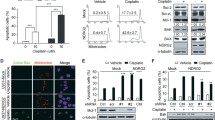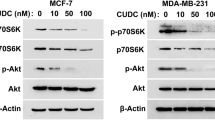Abstract
The molecular mechanism by which Profilin acts as a tumor suppressor is still unclear. Several chemotherapeutic agents, used till date either have unfavorable side effects or acquired resistance in tumor cells. Our findings show that Profilin enhances cell death mediated by several chemotherapeutic-agents. The activation of NF-κB and its dependent genes, mediated by paclitaxel and vinblastine, was completely inhibited in Profilin overexpressing cells. This inhibition was due to the Profilin mediated attenuation of IκBα degradation, thereby preventing p65 nuclear translocation and low NF-κB DNA binding activity.Moreover, Profilin increases level of p53 in the presence of known inducers, such as doxorubicin, vinblastine, and benzofuran. This increased p53 level leads to enhanced cell death as indicated by activation of caspases 3, 8, 9, which results in cleavage of PARP.Furthermore, knocking down of p53 in Profilin overexpressing cells leads to decreased cell death. Ectopic expression of Profilin in HCT116 p53 knock out cells showed lesser cell death as compared to the HCT116 p53 wild type cells. For the first time, we provide evidences, which suggest that Profilin synergizes with chemotherapeutic drugs to induce tumor cell death by regulating NF-κB and p53. Thus, modulation of Profilin may be a useful strategy for effective combination therapy.








Similar content being viewed by others
Abbreviations
- ANG1:
-
Angiopoietin-1
- AraC:
-
Arabinoside C
- ATRA:
-
All-trans retinoic acid
- DAPI:
-
4′,6-Diamidino-2-phenylindole
- ICAM:
-
Intercellular cell adhesion molecule
- IL:
-
Interleukin
- Mdm2:
-
Mouse double minute 2 homolog
- MTT:
-
3-(4,5-dimethylthiazol-2-yl)-2,5-diphenyltetrazolium bromide
- NF-κb:
-
Nuclear transcription factor kappa B
- PARP:
-
Poly-ADP ribose polymerase
- Sp1:
-
Specificity protein 1
- VEGF:
-
Vascular endothelial growth factor
References
Figley MD, Bieri G, Kolaitis RM, Taylor JP, Gitler AD (2014) Profilin 1 associates with stress granules and ALS-linked mutations alter stress granule dynamics. J Neurosci 34:8083–8097
Peng ZM, Yu W, Xie Y, Peng WH, Cao HH, Shen JH et al (2014) A four actin-binding protein signature model for poor prognosis of patients with esophageal squamous cell carcinoma. Int J Clin Exp Pathol 7:5950–5959
Xue B, Leyrat C, Grimes JM, Robinson RC (2014) Structural basis of thymosin-β4/profilin exchange leading to actin filament polymerization. Proc Natl Acad Sci USA 111:E4596–E4605
Ding Z, Joy M, Bhargava R, Gunsaulus M, Lakshman N, Miron-Mendoza M et al (2014) Profilin-1 downregulation has contrasting effects on early vs late steps of breast cancer metastasis. Oncogene 33:2065–2074
Zou L, Jaramillo M, Whaley D, Wells A, Panchapakesa V, Das T et al (2007) Profilin-1 is a negative regulator of mammary carcinoma aggressiveness. Br J Cancer 97:1361–1371
Yao W, Ji S, Qin Y, Yang J, Xu J, Zhang B et al (2014) Profilin-1 suppresses tumorigenicity in pancreatic cancer through regulation of the SIRT3-HIF1α axis. Mol Cancer 13:187
Pečar Fonović U, Jevnikar Z, Rojnik M, Doljak B, Fonović M et al (2013) Profilin 1 as a target for cathepsin X activity in tumor cells. PLoS ONE 8:e53918
Zou L, Ding Z, Roy P (2010) Profilin-1 overexpression inhibits proliferation of MDA-MB-231 breast cancer cells partly through p27kip1 upregulation. J Cell Physiol 223:623–629
Wilson L, Jordan MA (1994) Pharmacological probes of microtubule function. In: Hyams JS, Lloyd CW (eds) Microtubules. Wiley, New York, pp 59–83
Jordan MA, Hadfield JA, Lawrence NJ, McGown AT (1998) Tubulin as a target for anticancer drugs: agents which interact with the mitotic spindle. Med Res Rev 18:259–296
Concin N, Stimpfl M, Zeillinger C, Wolff U, Hefler L, Sedlak J et al (2003) Role of p53 in G2/M cell cycle arrest and apoptosis in response to γ- irradiation in ovarian carcinoma cell lines. Int J Oncol 22:51–57
Bunz F, Dutriaux A, Lengauer C, Waldman T, Zhou S, Brown JP et al (1998) Requirement of p53 and p21 to sustain G2 arrest after DNA damage. Science 282:1497–1501
Sax JK, Fei P, Murphy ME, Bernhard E, Korsmeyer SJ, El-Deiry WS (2002) BID regulation by p53 contributes to chemosensitivity. Nat Cell Biol 4:842–849
Delbridge ARD, Strasser A (2015) The BCL-2 protein family, BH3-mimetics and cancer therapy. Cell Death Diff 22:1071–1080
Parrish AB, Freel CD, Kornbluth S (2013) Cellular mechanisms controlling caspase activation and function. Cold Spring Harb Perspect Biol 5:a008672
Wiita AP, Ziv E, Wiita PJ, Urisman A, Julien O, Burlingame AL et al (2013) Global cellular response to chemotherapy-induced apoptosis. eLife 2:e01236
Piette J, Neel H, Maréchal V (1997) Mdm2: keeping p53 under control. Oncogene 15:1001–1010
Bond GL, Hu W, Bond EE, RobinsH LutzkerSG, Arva NC et al (2004) A Single Nucleotide Polymorphism in the MDM2 promoter attenuates the p53 tumor suppressor pathway and accelerates tumor formation in humans. Cell 119:591–602
Kaku S, Iwahashi Y, Kuraishi A, Albor A, Yamagishi T, Nakaike S, Kulesz-Martin M (1993) Binding to the naturally occurring double p53 binding site of the Mdm2 promoter alleviates the requirement for p53 C-terminal activation. Nuc Acids Res 29:1989–1993
Chene P (2004) Inhibition of the p53-MDM2 Interaction: targeting a Protein-Protein Interface. Mol Cancer Res 2:20–28
Gu L, Findley HW, Zhou M (2002) MDM2 induces NF-kappaB/p65 expression transcriptionally through Sp1-binding sites: a novel, p53-independent role of MDM2 in doxorubicin resistance in acute lymphoblastic leukemia. Blood 99:3367–3375
Karin M (2009) NF-κB as a critical link between inflammation and cancer.Cold Spring Harb Perspect. Biol 1:a000141
Manna SK, Bose JS, Gangan V, Raviprakash N, Navneetha T, Raghavendra PB et al (2010) Novel derivative of benzofuran induces cell death mostly by G2/M cell cycle arrest through p53-dependent pathway but partially by Inhibition of NF-kB. J Biol Chem 285:22318–22327
Mahali S, Raviprakash N, Raghavendra PB, Manna SK (2011) Advanced glycation end products (AGE) induce apoptosis via a novel pathway: involvement of Ca2+ mediated by interleukin-8. J Biol Chem 286:34903–34913
Liu DX, Lobie PE (2007) Transcriptional activation of p53 by Pitx1. Cell Death Differ 14:1893–1907
Sreenivasan Y, Sarkar A, Manna SK (2003) Mechanism of Cytosine arabinoside mediated apoptosis: role of Rel A (p65) dephosphorylation. Oncogene 22:4356–4369
Raviprakash N, Manna SK (2014) Short-term exposure to oleandrin enhances responses to IL-8 by increasing cell surface IL-8 receptors. Br J Pharmacol 171:3339–3351
Sarkar A, Sreenivasan Y, Ramesh GT, Manna SK (2004) Beta-D-glucoside suppresses TNF-induced activation of nuclear transcription factor kappaB but potentiates apoptosis. J Biol Chem 279:33768–33781
Wittenmayer N, Jandrig B, Rothkegel M, Schlüter K, Arnold W, Haensch W et al (2004) Tumor suppressor activity of profilin requires a functional actin binding site. Mol Biol Cell 15:1600–1608
Charalambous C, Pen LB, Su YS, Milan J, Chen TC, Hofman FM (2008) Interleukin-8 differentially regulates migration of tumor-associated and normal human brain endothelial cells. Cancer Res 65:10347–10354
Pakala R, Watanabe T, Benedict CR (2002) Induction of endothelial cell proliferation by angiogenic factors released by activated monocytes. Cardiovasc Radiat Med 3:95–101
Claffey KP, Abrams K, Shih SC, Brown LF, Mullen A, Keough M (2001) Fibroblast growth factor 2 activation of stromal cell vascular endothelial growth factor expression and angiogenesis. Lab Invest 81:61–75
Choi YH, Yoo YH (2012) Taxol-induced growth arrest and apoptosis is associated with the upregulation of the Cdk inhibitor, p21WAF1/CIP1, in human breast cancer cells. Oncol Rep 28:2163–2169
Acknowledgments
This work was supported by the core grant of Centre for DNA Fingerprinting and Diagnostics (CDFD). We thank Council for Scientific and Industrial Research (CSIR), Department of Biotechnology (DBT) and University Grants Commission (UGC), Govt. of India for providing fellowships to AZ, RBM, and PG, respectively.
Author information
Authors and Affiliations
Corresponding author
Ethics declarations
Conflict of interest
All authors declare no conflict of interest.
Electronic supplementary material
Below is the link to the electronic supplementary material.
Rights and permissions
About this article
Cite this article
Zaidi, A.H., Raviprakash, N., Mokhamatam, R.B. et al. Profilin potentiates chemotherapeutic agents mediated cell death via suppression of NF-κB and upregulation of p53. Apoptosis 21, 502–513 (2016). https://doi.org/10.1007/s10495-016-1222-9
Published:
Issue Date:
DOI: https://doi.org/10.1007/s10495-016-1222-9




